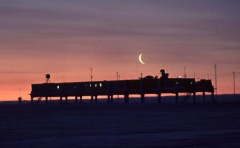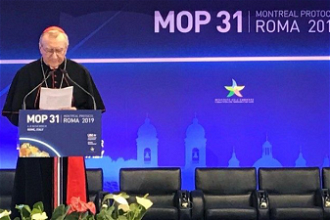Tribute to scientist who discovered hole in ozone layer

British Antarctic Survey research station Halley-5 winter 1999 - Wiki images
A Service of Thanksgiving for the life of scientist Joe Farman, was held in the Chapel of Corpus Christi College, Cambridge on Thursday 23 May.
Columban Fr Sean McDonagh has written the following tribute.
Although I never met him, Joe Farman who died last week, was one of my heroes. He was born in Norwich and after finishing High School he won a scholarship to Corpus Christi College, Cambridge where he studied the natural sciences. In 1956, he joined the Falkland Island Dependency Survey, later renamed the British Antarctic Survey as a geophysicist.
For decades humans had been releasing tonnes of dangerous chemical compounds into the atmosphere. Unknown to most people, some of these chemicals were causing drastic changes to the Earth's atmosphere, especially the ozone layer. The ozone layer plays a vital role in blocking the ultraviolet rays of the sun which can cause skin cancer and other health problems to humans and other creatures.
In the 1970s, two American scientists Mario Molina and F Sherwood Rowlands, discovered that chlorofluorocarbons (CFCs), which were found in propellants in everyday products such as hairsprays and household fridges, were contributing to the destruction of the ozone layer. The chemical companies which manufactured CFCs were very powerful politically and were unwilling to concede that their products might be doing such enormous damage. In response to the research of the above scientists, the NASA Space Center in the United States began to collect data on the ozone layer.
With the arrival of Margaret Thatcher as Prime Minister in 1979, there were major cuts across the public services, but being a chemist herself, Thatcher supported Farman's work and ring-fenced the Antarctic Survey budget. However, some of Farman's superiors suggested that he cease his research on the ozone layer since the data had hardly changed in the 25-year period during which he was collecting the data. They also felt that the NASA data from satellites would be much more accurate than land-based data. Farman continued taking ground-level readings.
In the beginning of the 1980s, things began to change dramatically. The data which Farman and his colleagues collected with his 25-year-old Dobson spectrophotometer was so unusual that he thought the machine was faulty. Farman ordered new machines. He repeated his study over a number of years with the new equipment and the results from it were even more startling. In May 1984, Farman and his two colleagues, Jonathan Shanklin and Brian Gardiner, published their results in the prestigious journal Nature. Based on their data, the article claimed that ozone levels over the Antarctic had fallen by 40 percent from 1975 to 1984.
The article came as a shock to the scientific community, because of the fact that the much better resourced and technologically superior NASA programme had not picked up the data or sounded the alarm. What transpired was most bizarre. NASA was forced to admit that, while its satellites had picked up the data, their computers did not highlight the depletion of the ozone layer because it was programmed to disregard data that seemed unfeasible. When the data was rechecked the satellites had picked up a hole in the ozone layer over the Antarctic which was as large as the United States. The importance of Farman's findings were underscored by a study by the United States Environmental Protection Agency (EPA). It found that increased exposure to ultraviolent radiation caused by the hole in the ozone layer could be responsible for 40 million cases of skin cancer and 800,000 cancer deaths in the United States over the next 88 years.
As a direct result of Farman's work, a treaty, called the Montreal Protocol, designed to phase out ozone-depleting compounds, was signed by 24 countries in 1987. It has now been ratified by 200 countries. Kofi Annan, who was secretary general at the United Nations called The Montreal Protocol "perhaps the single most successful international treaty to date." The depletion of ozone levelled off in the early 2000s. Nevertheless, it could take between 80 to 100 years to repair the damage to the ozone layer.
In Farman's obituary in The New York Times, Paul Vitello wrote that: "his single-minded and at times officially derided study of atmospheric changes in the Antarctic established the existence of a hole in the ozone layer over the South Pole, approximately the size of the United States - one of the most important environmental discoveries in the 20th century." All humans and other creatures living now and all future creatures owe Joe Farman a huge debt of gratitude. When people ask what one person can do in terms of preventing environmental damage, I point to the achievements of Joe Farman.
Joe Farman died on 11 May 2013. He is survived by his wife Paula.
Columban Father Sean McDonagh is an eco-theologian based in Ireland.
















